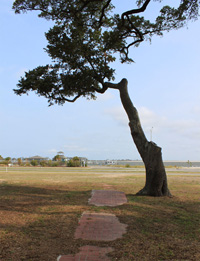Time-Honored Versus Bigger and Better: Critical and Strategic Conservation in Post-Katrina Mississippi
by Christopher L. Cosper (MDesS ’13)
 Hurricane Katrina struck the Mississippi Gulf Coast on August 29, 2005. Although much of the media’s attention focused on New Orleans and the horrific conditions at the Superdome, the strongest quadrant of the storm—the northeast quadrant—devastated the entire Mississippi coastline from Waveland in the west to Pascagoula in the east. Large areas of beachfront property were leveled, and approximately 60,000 homes were destroyed or made uninhabitable.
Hurricane Katrina struck the Mississippi Gulf Coast on August 29, 2005. Although much of the media’s attention focused on New Orleans and the horrific conditions at the Superdome, the strongest quadrant of the storm—the northeast quadrant—devastated the entire Mississippi coastline from Waveland in the west to Pascagoula in the east. Large areas of beachfront property were leveled, and approximately 60,000 homes were destroyed or made uninhabitable.
In October 2005, just six weeks after the storm, more than 100 planning and design professionals met for a week of design charettes—called the Mississippi Renewal Forum—to plan the future of all 11 coastal cities. These planners, members of the Congress for the New Urbanism, were led by Andrés Duany, the charismatic and often controversial leader of the New Urbanist movement.
The results of the planning charrettes were delivered to Mississippi’s leaders and the public in November, less than three months after the storm. (In contrast, the Louisiana and New Orleans replanning process took longer than two years.) The New Urbanist visions for the Gulf Coast created a sense of hope among the Coast population and they contributed to the appearance of planned recovery, which sped the delivery of federal funds to the Coast. However, the planning process also created tension among Coast leaders and the general public. The plans—completed during a series of late-night sessions—continue to influence the recovery of the Coast today.
 This paper examines the contradictory directives from the Mississippi Renewal Forum through the lens of Critical Conservation, which is based on an understanding of underlying cultural ecologies. As cultural geographers demonstrate, the south’s traditional culture is served by the nostalgic forms of New Urbanism. The directives to plan in a time-honored (traditional) manner conflicts with the idea of building in a bigger and better (future-oriented) manner. Cosper examined five case study projects, placing them within the cultural framework of Critical Conservation. With the exception of one of the case studies, all of these projects were designed post-Katrina, and most of them were heavily influenced by the Mississippi Renewal Forum. He argues that the New Urbanists who participated in the Mississippi Renewal Forum were deeply engaged in the debate between the time-honored and the bigger and better, and that they arrived on the Mississippi Gulf Coast with firmly held positions that influenced their planning work.
This paper examines the contradictory directives from the Mississippi Renewal Forum through the lens of Critical Conservation, which is based on an understanding of underlying cultural ecologies. As cultural geographers demonstrate, the south’s traditional culture is served by the nostalgic forms of New Urbanism. The directives to plan in a time-honored (traditional) manner conflicts with the idea of building in a bigger and better (future-oriented) manner. Cosper examined five case study projects, placing them within the cultural framework of Critical Conservation. With the exception of one of the case studies, all of these projects were designed post-Katrina, and most of them were heavily influenced by the Mississippi Renewal Forum. He argues that the New Urbanists who participated in the Mississippi Renewal Forum were deeply engaged in the debate between the time-honored and the bigger and better, and that they arrived on the Mississippi Gulf Coast with firmly held positions that influenced their planning work.
Faculty Advisors
Michael K. Hays, Eliot Noyes Professor of Architectural Theory, Thesis advisor
Jana Cephas, Instructor in Urban Planning and Design, Reader